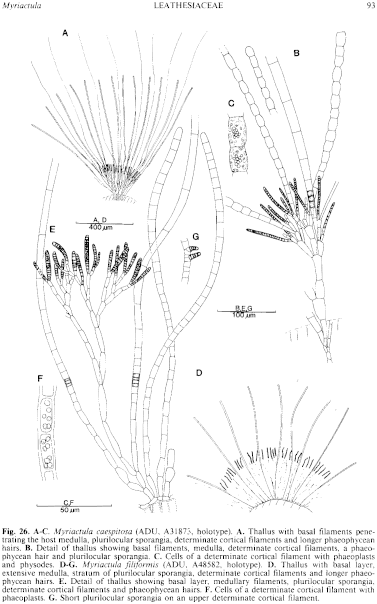|
|
|
|
|
|||||||||||
|
Electronic Flora of South Australia Species Fact Sheet
Phylum Phaeophyta – Order Chordariales – Family Leathesiaceae
Thallus (Fig. 26A) forming spreading, mucoid, patches, with older parts becoming tufted, about 1 mm high, on Scytosiphon, with endophytic basal filaments in the host, developing a moderately extensive medulla surmounted by a stratum of plurilocular sporangia and long, free, cortical filaments and hairs. Basal filaments (Fig. 26A,B) penetrating the cortical and inner parts of the host, branched, producing medullary and in turn cortical filaments through the host surface. Medulla (Fig. 26A,B) becoming extensive in older tufts, basally constricted at host cortex then spreading, 100–160 µm and 8–12 cells high, with branched filaments of cells 8–16 (–20) µm in diameter and L/B 1–2. Determinate cortical filaments (Fig. 26A,B) 500–800 µm and 30–40 cells long, of similar diameter throughout and with intercalary divisions, cells usually slightly swollen, 10–14 µm in diameter and L/B (1–) 1.5–2. Phaeoplasts (Fig. 26C) several per cell, more or less discoid, usually with a pyrenoid; physodes numerous and prominent, usually centrally clustered. Phaeophycean hairs frequent, arising from upper medullary cells, 10–14 µm in diameter.
Reproduction: Plurilocular sporangia (Fig. 26A,B) produced by upper medullary cells, forming a stratum at the base of the cortical filaments, uniseriate, 50–80 µm and (10–) 15–25 locules long, 4–6 µm in diameter.
Type from Wanna, S. Aust., on Scytosiphon, low eulittoral ( Womersley, 21.viii.1967); holotype in ADU, A31873.
Distribution: Only known from the type collection.
The spreading nature of the thallus, the penetration of the basal filaments within the host tissue, and the largely free determinate cortical filaments, place this species in Myriactula. The medulla is more strongly developed than in many species, but less so than in the following species.
References: The Marine Benthic Flora of Southern Australia Part II
Publication:
Womersley, H.B.S. (14 December, 1987)
The Marine Benthic Flora of Southern Australia
Part II
©Board of the Botanic Gardens and State Herbarium, Government of South Australia
Illustration in Womersley Part II, 1997: FIG. 26 A–C.

Figure 26 enlarge
Fig. 26. A–C. Myriactula caespitosa (ADU, A3187.±, holotype). A. Thallus with basal filaments penetrating the host medulla, plurilocular sporangia, determinate cortical filaments and longer phaeophycean hairs. B. Detail of thallus showing basal filaments, medulla, determinate cortical filaments, a phaeophycean hair and plurilocular sporangia. C. Cells of a determinate cortical filament with phaeoplasts and physodes. D–G. Myriactula filiformis (ADU, A48582, holotype). D. Thallus with basal layer, extensive medulla, stratum of plurilocular sporangia, determinate cortical filaments and longer phaeophycean hairs. E. Detail of thallus showing basal layer, medullary filaments, plurilocular sporangia, determinate cortical filaments and phaeophycean hairs. F. Cells of a determinate cortical filament with phaeoplasts. G. Short plurilocular sporangia on an upper determinate cortical filament.

|
Email Contact: State Herbarium of South Australia |

|